In this season of love, we’re taking a look at 10 of Jamaica’s most captivating love stories. These stories of triumphant love gripped the nation and became indelibly entwined in the country’s social history and lore.
Maurice and Valerie Facey
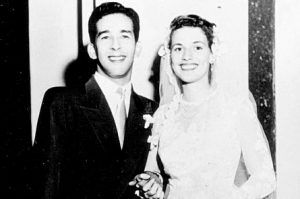
Image Source: The Jamaica Observer
Valerie Hart-Collins came to Jamaica from Europe at age 17. She arrived at Kingston Harbour on the banana boat the MS Bayan. As the boat approached the pier, she leaned over the rail of the boat’s deck to gaze at the beautiful city. It was then that Maurice Facey first laid eyes on the woman that would become his life partner. Within a year they fell in love and Maurice asked her to marry him. But Valerie’s parents refused to give their permission. They disapproved of Maurice as a mixed race Jamaican and insisted that Valerie was too young to get married. Still, the young lovers were unshaken and determined to become man and wife.
Valerie’s parents retained the legal services of none other than the eminent Norman Manley to prevent the wedding and even orchestrated to have Valerie arrested on the grounds of working in Jamaica without a permit. Valerie chose to spend the night in prison rather than be deported and separated from her love.
At the intervention of the then Governor of Jamaica, Sir Hugh Foot, they were finally allowed to marry without parental consent. It was a sensational scandal in 1950s Jamaica. Valerie and Maurice were married in a packed St. Andrew Parish Church in Half Way Tree. Hundreds of Jamaicans had come out to see the obstinate young lovers who had caused such a stir.
Their story certainly didn’t end there, however. In his early days as a businessman, Maurice experienced setbacks. In 1956 after the collapse of a business project, the family sold their Norbrook home and its entire contents. The Faceys and their two children left the house with nothing but the clothes on their backs. During these difficult times, Valerie remained by her husband’s side. Maurice Facey lived to become one of Jamaica’s most successful and wealthy businessmen. They were married for 61 years before Maurice died in 2013. Looking back on their relationship, Valerie has said, “It was a marriage made in heaven…there is no marriage that is easy but I think we had a very good marriage, we fought the battle well.”
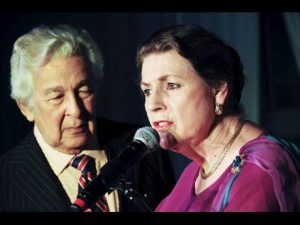
Image Source: The Jamaica Gleaner
Sources:
“10 things you didn’t know about Valerie Facey.” The Jamaica Gleaner, 5 January 2014, http://jamaicagleaner.com/gleaner/20140105/out/out2.html
Allen, Desmond. “Valerie and Maurice Facey: A 60-year marriage that should not have been.”, The Jamaica Observer, 21 April, 2013. http://www.jamaicaobserver.com/news/Valerie-and-Maurice-Facey–A-60-year-marriage-that-should-not-have-been_14109521
“Portraits -Valerie Facey – Lucky Victim of Fate” https://www.youtube.com/watch?v=XdkGu1uD2Xg
Louise Bennett and Eric Coverley
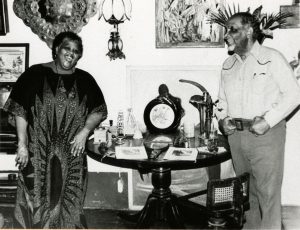
Louise and Eric at their home in Gordon Town
What can we say about the beloved Miss Lou? Simply that to know her was to love her – and perhaps no one knew her better than Eric Coverley. Louise Bennett met Eric ‘Chalk Talk’ Coverley, a popular actor and talent scout, in 1936 at a prize-giving concert at her alma mater, Excelsior. She asked him for autograph and he congratulated her on her performance. Eric invited her to be part of a Christmas concert at the Coke Memorial Hall (after asking her mother’s permission of course). The rest, as they say, is history.
They remained close friends for many years, during which time Louise lived in England and New York. While on a trip to New York in 1953, Eric called Louise on her birthday. They reconnected and began working together, co-directing a folk musical called, Day in Jamaica. Eric would often escort her home after a performance or engagement before having to rush away to catch a late train back to where he was staying. It was one such night when he said to her, ‘Louise I can’t stop a minute to talk with you. It seems that I will just have to marry you.” In true Miss Lou fashion, Louise responded “Coverley, is that the way you propose? That could never be a proposal!”. She must have accepted because they were married on May 30, 1954 in Harlem. He was 42, she was 35.
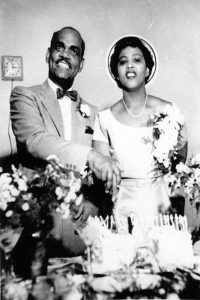
The Coverleys on their wedding day
After returning to Jamaica in 1955, both continued their work in the arts. Enfield House, their home in Gordon Town, was the site of many celebrations and gatherings. Though they never had any biological children together, Eric and Louise often welcomed the children of extended relatives and community members into their home. They brought up these children together with Fabian, Eric’s son from a previous relationship.
When Eric’s health began to decline, he and Louise moved to Canada in 1987 to join Fabian who lived in Toronto. Eric died at age 91 in 2002 and Louise would follow four years later in July 2006.
Click here to view the NLJ’s Miss Lou Archives – including published and unpublished materials, photographs and audio-visual materials housed at the National Library of Jamaica.
Sources:
Morris, Mervyn. Miss Lou: Louise Bennett and Jamaican Culture, Kingston: Ian Randle Publsihers, 2014.
“The Mother of Jamaican Culture Remembered”, The Jamaica Gleaner, 3 June 2012, http://jamaica-gleaner.com/gleaner/20120603/ent/ent5.html
Bob and Rita Marley
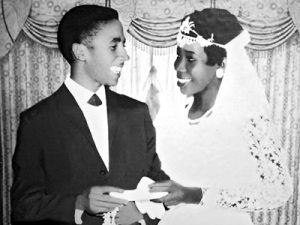
Image Source: The Jamaica Gleaner
Bob and Rita met at a studio in Trenchtown when he was just 19 and she was 18. Rita had already given birth to a daughter, Sharon. In her memoir, No Woman No Cry, Rita writes that it was his concern for her and her daughter that led her to fall in love with Bob, “He was very conscientious, and this was something that impressed me greatly – his sharing, his caring for my baby, and really allowing me to show more responsibility.” (Marley, 24) The first couple of reggae was married in the office of a Justice of the Peace in February 1966.
Rita joined The Wailers in 1968, after Bunny Livingston (Bunny Wailer) was imprisoned for marijuana possession and the group became short a member. Later in 1974, when Bunny Wailer and Peter Tosh left the group for good, Rita helped to assemble the I-Three female vocal trio along with Judy Mowatt and Marcia Griffiths. Rita followed Bob all over the world on tour and in studio for the remainder of his career.
She remained by his side through an infamous assassination attempt in 1976 (a bullet grazed her head and hit Bob’s arm) and his well-known assignations with other women. During his final battle with cancer, she cared for him and remained very protective of him. In 1981, Bob died at age 35, far too young. Rita, along with their children and grandchildren, continue to carry on the Marley legacy.
In the prologue of her book, No Woman No Cry: My Life with Bob Marley, she writes “But the thing about Bob is so deep, it is as if he’s always with me, there’s always something to remind me.”
Source: Marley, Rita, with Hettie Jones. Rita Marley: No Woman No Cry, Great Britain: Sidgwick & Jackson, 2004.
Edna and Norman Manley
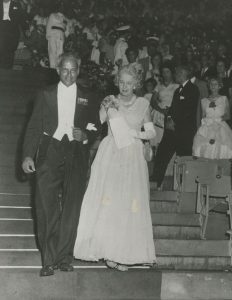
Image Source: NLJ
Norman and Edna were actually first cousins who met when Norman, a Rhodes Scholar, travelled to England to study at Oxford. Norman went off to serve in WWI and wrote to Edna from the front lines in France. He returned a decorated war hero but a changed man – having witnessed so much death and destruction – including the death of his brother, Roy. In her diaries, published by her granddaughter Rachel in 1989, Edna wrote about how she would rush to comfort Norman as nightmares of the war “made the night hideous for him” (80). She stayed close to him in those years and was instrumental in his recovery and return to school at Oxford.
They were married in London and moved to Jamaica upon Norman’s graduation. Norman’s work in law and politics led him to be known as ‘the father of the nation’, while Edna’s great contribution to art and culture earned her the title ‘the mother of Jamaican modern art’. As towering figures in Jamaica’s history, the stories of their public lives are well-known, but it is their commitment and passion for one another that cements them as one of Jamaica’s great love stories.
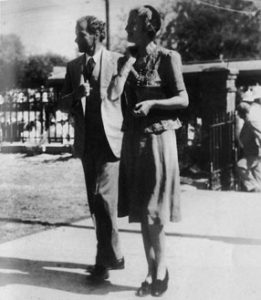
Image Source: NLJ
Edna Manley held great admiration for her husband and stood with him through victories and disappointments. She described the loneliness of her life after his death in September 1969, “the glory and the pain of our life together – what an empty, empty world – why didn’t he let me come with him?” (Edna Manley, 77). Edna died in her sleep, 18 days before her 87th birthday, in February 1987. She is buried at her husband’s side at National Heroes Park.
“So it slowly ripened from friendship to something more – something that lasted a lifetime to that last journey down the mountainside in Jamaica.” (Edna Manley’s diaries, 81)
Sources:
“Jamaica mourns Edna Manley.” National Library of Jamaica, 11 February 1987, http://www.nlj.gov.jm/files/u7/bn_manley_es_050.pdf
Manley, Rachel. Horses in Her Hair: A Granddaughter’s Story, Toronto Key Porter Books, 2008.
Manley, Edna. Edna Manley: The Diaries, Kingston: Heinemann Publishers, 1989.
Beenie Man and Carlene Smith

Beenie Man and Carlene in the 90’s
All hail the first couple of dancehall!
Anthony Moses ‘Beenie Man’ Davis and Carlene ‘The Dancehall Queen’ Smith ruled the 90’s dancehall scene. Carlene was crowned Dancehall Queen in 1992 and was featured in the music video for Chaka Demus and Plier’s hit song, ‘Murder She Wrote’. The King of the Dancehall, Beenie Man gained international acclaim with Carlene appearing in several of his videos and stage performances, including ‘Wickedest Slam’ and ‘Kette Drum’.
Amid excessive media attention, the couple split up in 2000. It was an amicable break-up and the couple never publicly gave a reason for their split. They have a daughter, Crystal, who Carlene describes as ‘her world’. Today, Beenie and Carlene remain friends and often speak publicly about their mutual respect for each other.
Sources:
Dillon, Renee. “Real Talk: Dancehall Queen Carlene”, The Jamaica Star, 26 November 2015, http://jamaica-star.com/article/features/20151126/real-talk-dancehall-queen-carlene
Shapiro, Sherry B. Dancehall in a World of Change: Reflections of Globalization and Cultural Difference. Human Kinetics, 2008.
Cindy Breakspeare and Bob Marley
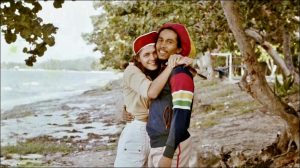
Image Source: NLJ
This is the Tuff Gong’s second appearance on this list. His romance with Jamaica’s beauty queen, Cindy Breakspeare, sent tongues wagging worldwide – especially since he was still married to Rita. Whether you approve or not, the love story of the reggae superstar and the beautiful uptown girl is as captivating today as it was then. Rumours still swirl that Bob wrote the sensuous songs ‘Turn Your Lights Down Low’ and ‘Is This Love’ for Cindy.
In 1977, Cindy became pregnant with their son, Damian. It was then that Bob’s mother Cedella told her that Rita was still Bob’s wife – although Bob had denied it. When Bob became ill with cancer, both Cindy and Rita travelled with him to Sloan Kettering in New York where he received treatment. Both women helped to care for him in his last days. When he died, Cindy sat ‘in the back row’ as ‘the other woman’ at his funeral at the National Arena.
Sources:
Grizzle, Shereita. “After 38 years, Marley – Breakspeare Still Sparks Debate.” The Jamaica Gleaner, 23 February 2014, http://jamaica-gleaner.com/gleaner/20140223/ent/ent10.html
Silvera, Janet. “Cindy finds out that Bob had Rita; Damian Marley is born.” The Jamaica Gleaner, 23 February 2014, http://jamaica-gleaner.com/gleaner/20140223/ent/ent9.html
Carl and Rosemarie Stone

University professor Carl Stone was a distinguished political scientist and opinion pollster with an international reputation. He made major contributions to political analysis in Jamaica and was deeply committed to his work as an educator. He and his wife Rosemarie had two children and led what seemed like a perfect life. But there was a dark side to Carl – one of infidelity, promiscuity and a predilection for nightclubs and bars. Carl’s lifestyle caught up with him when he was diagnosed with HIV/AIDS, though it was never determined exactly how he contracted the disease. In a heartbreaking turn of events, he passed it on to his wife, Rosemarie in 1992.
Carl and Rosemarie’s is a controversial but important story of enduring love in the face of illness and betrayal. Staying true to her marriage vows of ‘til death do us part’, Rosemarie cared for her husband during his illness and until his death in February 1993, at the age of 52. In 2007, Rosemarie wrote a gripping memoir, No Stone Unturned. In a heartbreaking scene from the book, she recounts how her husband sobbed uncontrollably as the doctor announced “I am sorry Mrs. Stone, your tests are positive.”
Still, Rosemarie holds no ill-will for her late husband. She writes in a letter to her children:
“He loved me in a special way because I was his wife and understood him more than anyone else. I also forgave him for any wrong doing that he did to me during the course of his life. I forgave him because I know that it was not wilfully done. But in his humanity he erred many times.” (Stone, 117)
Today, Rosemarie Stone is an advocate for persons living with HIV/AIDS. Speaking to a group of university students in 2008, she expressed, “If the book can help one person lessen his risky behaviour or avoid it all together, all the pain of writing the book would be worth it.”
Source: Stone, Rosemarie. No Stone Unturned, Kingston: Ian Randle Publishers, 2007.
Alexander and Gladys Bustamante
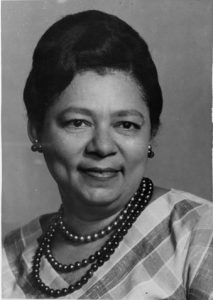
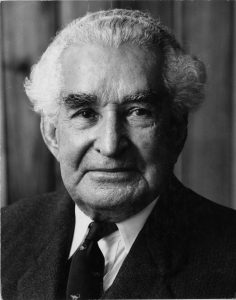
Gladys Longbridge met Alexander Clarke (before he was Bustamante) in 1934 at the Arlington House Hotel and Restaurant, where she worked as a clerk. At 22, he was 28 years her senior. Impressed with her work, he offered her a job at his office on Duke Street. In the following years, Gladys became his closest friend and confidant, often driving him around the island for his many engagements. In 1962, after the JLP’s victory in the general elections, the newly sworn in Prime Minister Bustamante announced that he would marry Gladys to the surprise of everyone…including Gladys. They were married that same year in a quiet ceremony.
As a Prime Minister’s wife, Lady Bustamante was the picture of grace as she welcomed foreign dignitaries and local workers alike.
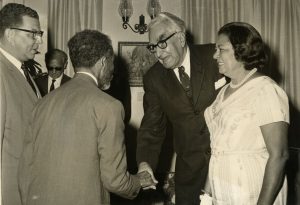
Sir Alexander and Lady Bustamante greet Emperor Selassie I. Donald Sangster looks on
After retiring from public life, they spent their time at their Irish Town home, Bellencita, where Lady Bustamante looked after her ‘Chief’. After his death in August 1977, she was ‘paralysed with grief’ and threw herself into work with several charities and causes – including the Bustamante Hospital for Children (named for her husband). She died 32 years after her husband in August 2009, at the full age of 97.
Today, Lady Bustamante is remembered for her generous work and life of service to the Jamaican people. Even in death, she is by her husband’s side – they are both buried at National Heroes Park.
Looking back on her life with her beloved, she wrote:
“I look back now with wonder and thankfulness that from the very beginning of that service until the end of his days, I was privileged to stand with Alexander Bustamante, behind him at first and beside him ever after.” (Bustamante, 38)
Source: The Memoirs of Lady Bustamante, Kingston Publishers Limited, 1997.
Anne and George William Gordon
George William Gordon is the third National Hero to make an appearance on our list. We think it’s time to retire the myth that Jamaican men don’t care about romance!
A wealthy business man and land owner in St. Thomas, George William Gordon paid the ultimate price for his commitment to the freedom of the Jamaican people. After the 1985 Morant Bay Rebellion, the then Governor of Jamaica, John Eyre, flew into a rage and sought merciless reprisals on those who had participated. Among the atrocities was the hurried conviction of George William Gordon on suspicion of having planned the rebellion. Gordon was tried for high treason at Hibbert House on Duke Street (where Jamaica National Heritage Trust now stands) and was sentenced to death by hanging.
In the hours before his death, George William Gordon wrote his final letter to his wife, Anne (whom he called Lucy). The heart-breaking letter is rife with anguish, as he says goodbye to his beloved.
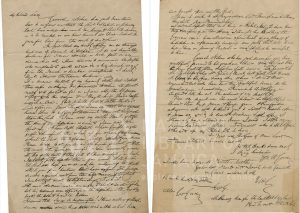
My beloved Lucy,
General Nelson has just been kind enough to inform me that the Court Martial on Saturday last has ordered me to be hung and that the sentence is to be executed in an hour hence so that I shall be gone forever from this [world] of sin and sorrow…
Gordon avows his innocence repeatedly in the letter, insisting “I do not deserve this sentence for I never advised or took part in any insurrection…I don’t think I deserved The Extreme Sentence.”
The Gordons’ love story is one all Jamaicans share in as this last letter reminds us that the freedoms we often take for granted today came at great personal cost to those brave enough to fight for them.
Sources:
Golding, Steven. “Sigh! No one remembers old George Gordon.” The Jamaica Observer, 10 January 2016, http://www.jamaicaobserver.com/columns/Sigh–No-one-remembers-old-George-Gordon_47198
George William Gordon’s last letter to his wife, 1985. (from the NLJ collections)
The Lovers of Lover’s Leap

Image Source: The Georgian Society of Jamaica
Over the centuries, the details of this tragic love story have changed and evolved into myth. Nonetheless, its message of passion and consuming love has endured. As the story goes, the two young lovers lived in miserable slavery in 17th century St. Elizabeth. Their love sparked the jealousy of the owner of Chardley Hall Estate, Richard Chardley, who wanted the young woman for himself. He threatened them both, and forbid them from meeting. The young woman’s brother warned her not to have anything more to do with the young man and to instead indulge Chardley – who held the power to make their lives easier. The two lovers were forced to meet in secret, stealing away to the nearby lookout at the top of a high cliff. But they were not alone. The brother had seen them and reported back to Chardley, who arranged to have the young woman sold. The two lovers fled and were chased up to the high cliff where they chose death over separation and plummeted 1, 600 feet from the top of the cliff into the rough waters below.
Today, Lover’s Leap is a popular tourist spot, boasting a beautiful view that overlooks Rocky Point, Clarendon in the east all the way to Treasure Beach in the west. The location hosts tours, weddings and, events. A wooden carving honours the two young lovers for whom the place is named.
Do you have a captivating love story to share? Do you think we left out a couple? Let us know in the comments or send us an email at nljsocial@nlj.gov.jm.
The sources listed here are available in the collections of the National Library of Jamaica. Visit us today at 12 East Street or online at nlj.gov.jm.

Since love is base on principle and that principle is that each party cherish each other and not breaking sacred vowes, Bob Marley should not be included in this list. His was a life of lust and infatuation and lack of regard for the females in his life. Love does not seek to gratify self but seeks the good of the other. He gratify himself at all cost and the women who were so infatuated they could not see the truth about him if it was paste in their hand middle.
I agree with you wholeheartedly.
It is extremely difficult to reconcile Bob Marley’s selfish private sex life with the astounding worldwide appeal of his music and lyrics. I think this is what has delayed his inclusion on the list of National Heroes. We have a serious problem of eating our cake & having it in this Bob Marley case. We want to …but should we on moral grounds and the message it would send to our profligate male population.
I knew Bob would be in here twice.
I don’t believe Bob’s private life is what has stopped him from being on the list of National Heroes, however.
I think it’s more Jamaica wrestling with what should be the criteria for a National Hero.. some believe it should remain people who made significant political stands and contributions. Others believe it should be include individuals who has significant achievement, which is how Bob Marley and Usain Bolt usually come up.
i was looking for famous jamaican Letters during Slavery iread some once in the Jamaican Gleaner,is it possible finding them.